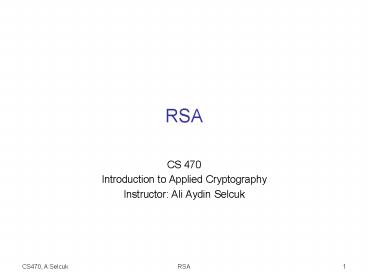CS 470 - PowerPoint PPT Presentation
Title:
CS 470
Description:
RSA CS 470 Introduction to Applied Cryptography Instructor: Ali Aydin Selcuk CS470, A.Selcuk RSA * CS470, A.Selcuk RSA * RSA First successful public key system ... – PowerPoint PPT presentation
Number of Views:41
Avg rating:3.0/5.0
Title: CS 470
1
RSA
- CS 470
- Introduction to Applied Cryptography
- Instructor Ali Aydin Selcuk
2
RSA
- First successful public key system (Rivest,
Shamir, Adleman, 1977). - Q Would a DH-like PKC as xe mod p work?
- RSA
- Alice chooses large primes p, q n pq.
- e, such that gcd(e, ?(n)) 1.
- d e-1 mod ?(n)
- n, e public. d is the private key.
- Encryption E(x) xe mod nDecryption D(x)
xd mod n
3
RSA Encryption
- Encryption y E(x) xe mod n,
- Decryption D(y) yd mod n.
- Why does it work?
- D(y) (xe)d mod n xed mod n x k?(n)
1 mod n, for some k (x?(n))k x mod n
x, if x ? Zn (what if not?)
4
Generation of RSA Parameters
- p, q can be generated randomly.
- ?(n) (p-1)(q-1)
- choosing e, gcd(e, ?(n)) 1
- Take e to be a prime.
- Generate p, q, such that e ? (p 1), e ? (q
1). - Compute d e-1 mod ?(n) by ext. Euclids.
- Popular e 3, e 65537.
- Randomness of d due to n.
5
Security of RSA
- Based on difficulty of factoring large integers.
- NFS e(1.923 O(1)) ((ln n)(1/3)) ((ln ln
n)(2/3))(btw, factoring is reducible to DLP in
Zp) - Computing d is equivalent to factoring n. (i.e.,
given d and e, one can find p and q.) - RSA problem Given n, e, xe mod n, what is
x?(conjecture It is equivalent to factoring n.) - Bit Security of RSA Computing LSB(x) is
equivalent to computing the whole x.
6
Signing with RSA
- Signature y S(x) xd mod n
- Verification ye mod n x ?
- Some problems
- Existential Forgery x ye mod n(solution?)
- Distributiveness Given (x1,S(x1)), (x2,S(x2)),
attacker can compute S(x1x2) S(x1)S(x2). - Or, similarly, S(x1/x2) or any S(x1ix2j) can be
computed. - Smooth numbers threat This may be significant
when messages to be signed are small. (solution?)
7
Optimizing RSA Private Key Op.s
- Instead of xd mod n, compute xd mod p xd
mod qand obtain xd mod n by the CRT. - For dp d mod (p 1), dq d mod (q 1), xd
xdp (mod p) xd xdq (mod q)hence, halving
the size of the modulus the exponents. - Approximately 2-3 times speedup.
- Q Can this be utilized for the public key
operations as well?
8
e 3 Issues
- Cube root problem
- Encryption If a small msg (i.e. x lt n1/3) is
encrypted, attacker can solve x from x3 mod n. - Signature If short msg.s are padded randomly at
LSBs, attacker can sign any short msg x - attacker pads x with 0s on the LSBs,
- computes its cube root,
- rounds up to the nearest integer r,
- take the padded message as r3.
9
e 3 Issues (cont.)
- Broadcast problem
- Bob, Bart, Bert all use e 3 with mods n1, n2,
n3. - Alice sends the same message x to all x3 mod
n1 x3 mod n2 x3 mod n3 - Eve computes y x3 mod n1n2n3 by the CRT.
- Which is y x3, since x lt n1, n2, n3, and x is
the cube root of y.
10
PKCS Solutions(RSA Labs)
- Encryption (PKCS 1 v1.5, RFC 2313)
- first 0 to guarantee x lt n
- 2 indicates encryption
- second 0 indicates end of padding
- Protects against
- guessable message attacks (e.g., a yes/no
message) - cube root problem, for e 3
- broadcast problem, for e 3
11
PKCS (cont.)
- Signature (PKCS 1 v1.5)
- Why not random padding?
- Why include the hash type?
12
PKCS v2
- Encryption Optimal Asymmetric Encryption
Padding (OAEP) - Bellare Rogaway, 1994. Adopted for PKCS 1 v2
(RFC 3447). - Message m, padded with 0s and random r, passes
through a Feistel-like structure and is then
encrypted with RSA. - Padding is provably secure assuming that hash
fnc. G H behave randomly.
13
PKCS v2 (cont.)
- Signature Probabilistic Signature Scheme (PSS)
- Bellare Rogaway, 1996.
- Provably secure (OAEP) assuming hash functions
produce random outputs. (Random oracle
assumption) - Adopted for PKCS 1 v2.1.































